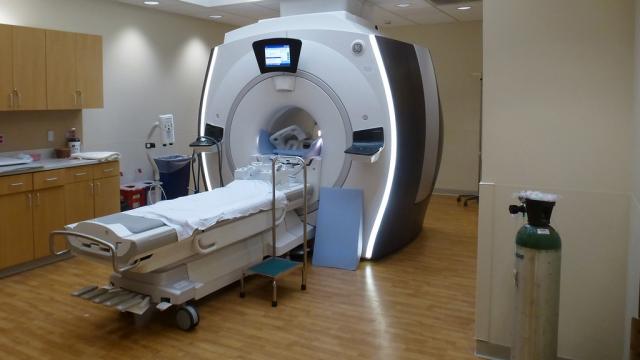MRI machines use a powerful magnetic field to produce internal images of the human body. The magnetic fields are so powerful that hospitals take great care to ensure no iron-containing metals come near the machines while they are in use. In rare cases, however, mistakes happen. This past weekend, an Indian man visiting a sick relative had the misfortune of carrying a metal oxygen cylinder into a hospital room where an MRI scanner was active, sucking him in and ultimately causing his death.
Image: Liz West/Flickr
As AFP reports, the deceased, 32-year-old Rajesh Maru, was visiting a relative at Nair Hospital in Mumbai, India, when the incident happened. Preliminary reports suggest the man died after inhaling the liquid oxygen that poured from the cylinder after it collided with the MRI machine. The cylinder apparently ruptured after hitting the scanner.
A junior staff member of the hospital had asked Maru to carry the cylinder into the room after assuring him the machine was inactive, according to the victim’s uncle.
“We have arrested a doctor and another junior staff member under section 304 of the Indian penal code for causing death due to negligence,” Mumbai police spokesperson Deepak Deoraj told AFP. The dean of the hospital, Ramesh Bharmal, told AFP that an investigation has been launched, and that CCTV footage of the incident has been given to police.
The state government of Maharashtra, of which Mumbai is the capital, said it would give the family ₹500,000 ($9700) as compensation.
MRI scanners work by forcing protons in the body to align with the powerful magnetic field produced by the machine. Patients are placed inside the scanner where they must lie perfectly still for an extended period of time to avoid blurring. Absolutely no loose ferrous metals are allowed in the room, as an active MRI machine will quickly turn them into deadly projectiles.
Sadly, these sorts of incidents have happened before. In 2014, also in India, two hospital workers were injured after becoming trapped between an MRI machine and a metal oxygen tank for four hours. And in a fatal incident in New York in 2001, a six-year-old boy had his skull crushed when a metal oxygen tank flew towards the machine. Other minor accidents have occurred in which loose pieces of metal have severely damaged the scanner, which range in price from $US150,000 ($185,990) to $US3 million ($3.7 million) depending on the unit.
Clearly, MRI machines and oxygen tanks are a deadly combination. Oxygen tanks are commonly used in hospital settings to administer oxygen to patients who are undergoing MRI procedures. The MRI Safety.com website makes the following recommendations:
In lieu of utilising pipes to directly deliver gases to patients, the use of non-magnetic (usually aluminium) gas cylinders is one means of preventing “missile effect” hazards in the MR environment.
[…] MRI centres should have a sufficient number of nonmagnetic oxygen tanks and strict policies in place to prevent staff members from introducing ferromagnetic objects into the MR environment. Notably, some hospital-based MRI facilities have nonmagnetic oxygen tanks used throughout their buildings to prevent projectile accidents.
Nonmagnetic tanks must be prominently labelled and/or colour-coded to avoid confusion with magnetic cylinders. Additionally, only regulators tested and demonstrated to be acceptable for use in a high magnetic field environment should be used with the nonmagnetic cylinders. Furthermore, all healthcare workers that work in the MR environment must be informed regarding the fact that only nonmagnetic oxygen and other gas cylinders are allowed into the MR system room.
MRISafety.com also recommends the use of nonmagnetic or weakly magnetic oxygen regulators, flow meters, cylinder carts, cylinder holders for wheelchairs, and suction devices.
This advice makes sense because it reduces the opportunity for human error. Arresting a doctor and a junior staff member for negligence seems harsh, and even a bit reactionary. Ultimately, the blame should be directed at the hospital for creating the conditions under which this accident happened.
